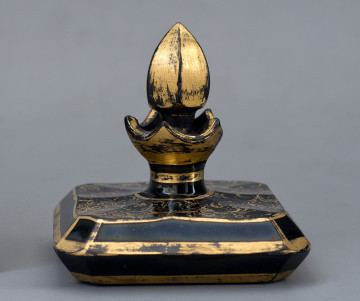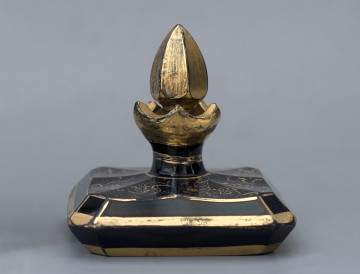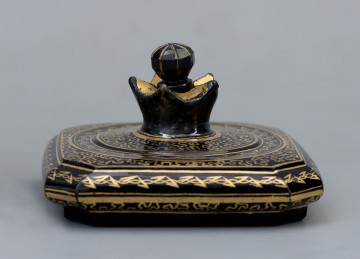
Vial with a cap
Museum of King Jan III's Palace at Wilanów
Part of the collection: Artistic glass
A small spherical vial with a cap, made of hyalith, with gilded decoration that is almost entirely abraded. It was most probably a perfume container. Its surface is embellished by two gilded stripes as well as other more complex elements which are almost impossible to identify today, e.g. a butterfly, a twig and another shape which remains a mystery. The cap is fully gilded.
The vial was made of hyalith (black glass), invented at the beginning of the 19th century by Georg Franz August Longueval, count of Buquoy (1781–1851). He was a mathematician, a physicist, a chemist, a philosopher as well as an owner of several glass factories. His broad interests and experiments led him to discover a new recipe for molten glass that has the characteristically deep black colour. Its production started in 1817. Owing to the unique hue, products made of hyalith, such as cups, vials, vases, tea containers or candle-holders, quickly became fashionable and widely in-demand. Most often they displayed gilded decorations which looked impressive against the black surface and made the items resemble Far Eastern artefacts made of lacquer. The vial from the Wilanów collection is an excellent example of such vessels in the elegant black colour. The popularity of hyalith, however, lasted for a relatively short period, i.e. until the 1840s, giving place to other types of glassware (mainly mass tinted glass of various colours), though hyalith vessels could still be found in the market.
Author / creator
Dimensions
entire object: height: 10,1 cm, width: 8,0 cm
Owner
Museum of King Jan III's Palace at Wilanów
Identification number
Location / status

Museum of King Jan III's Palace at Wilanów

Museum of King Jan III's Palace at Wilanów

Museum of King Jan III's Palace at Wilanów
DISCOVER this TOPIC
Castle Museum in Łańcut
DISCOVER this PATH
Educational path